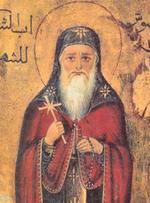Make your gift today!
Help keep Catholics around the world educated and informed.
Already donated? Log in to stop seeing these donation pop-ups.
Our Lady of Kursk
by Zsolt Aradi
The first historical data concerning the miraculous icon of Our Lady of Kursk go back to the year 1295. The holy image was found in that year at the foot of an old oak tree in the neighborhood of the city of Rilsk. At the moment when a passerby discovered the image, so the legend relates, a fountain suddenly sprang from the earth-- and this fountain still exists. The populace of the city and the neighboring province immediately erected a log chapel and placed the icon at its main altar.
In 1898, revolutionaries threw bombs into the cathedral of Kursk. The church and even that small corner where the icon was placed were heavily damaged. The image of the Mother of God, however, remained undamaged. In 1918, after the Bolshevik Revolution, the picture disappeared again from the monastery. It was found after two months at the bottom of a deep well concealed in a sack, robbed of all its jewels. During the fights of the revolutionaries with the White army, the image remained safely in the monastery of Kursk. But in 1919, the anti-Bolshevik army withdrew from Kursk and the population feared that the image might fall into the hands of the godless. Thus the icon was carried secretly and given from hand to hand. Finally, in 1920, it reached Constantinople where it did not remain very long, being taken away by Tsarist officers and priests into Yugoslavia. This country sheltered for a long time the refugees of the White Russian army and the highest representatives of the Russian Orthodox Church. Between the two wars, the miraculous image of Our Lady of Kursk continued to visit various centers of the Russian emigration. Always in the care of Metropolitan Anasthassy, it escaped destruction during World War II; its hiding place was known only to those entrusted with its safe-keeping. After the war, it was announced that the miraculous icon of Our Lady of Kursk was in Munich, Germany, but that it was in the care of only the highest dignitaries of the Russian Orthodox Church in exile.
The holy image of the Madonna of Kursk is at this time the most sacred relic of the entire Russian Orthodox Church in exile. After its short stay in Munich, it crossed the ocean and its temporary dwelling place today is in New York City at the chapel of the Synod of the Bishops of the Russian Orthodox Church. But it travels continuously. There is in the world no other holy image of Our Lady that has been carried to so many different places and countries; that has suffered such adventurous, dangerous voyages. Of this we can be certain: no matter how long this holy image is forced to remain far from its place of origin, there will be no permanent abode for her until she returns to the vicinity of the oak tree in the forest of Rilsk.
This item 3200 digitally provided courtesy of CatholicCulture.org






